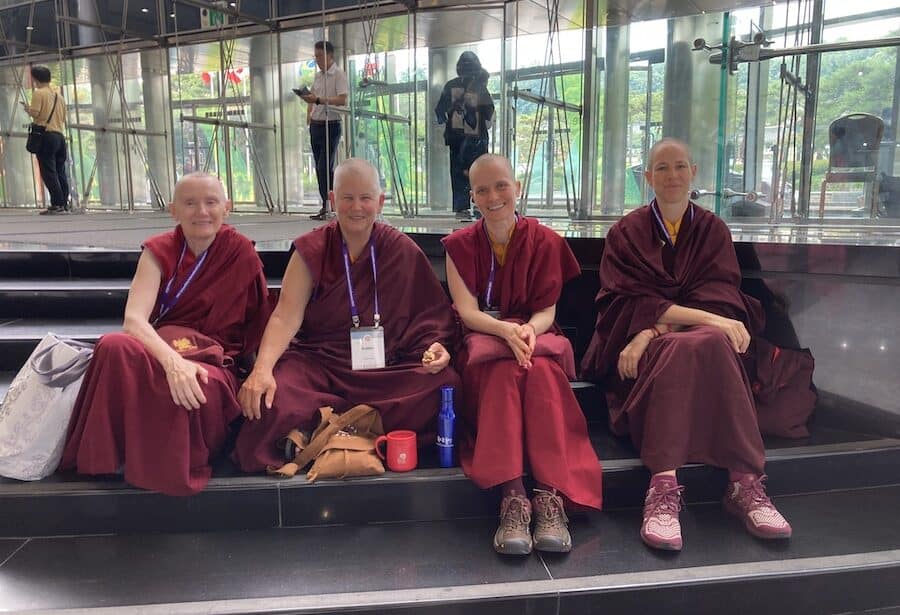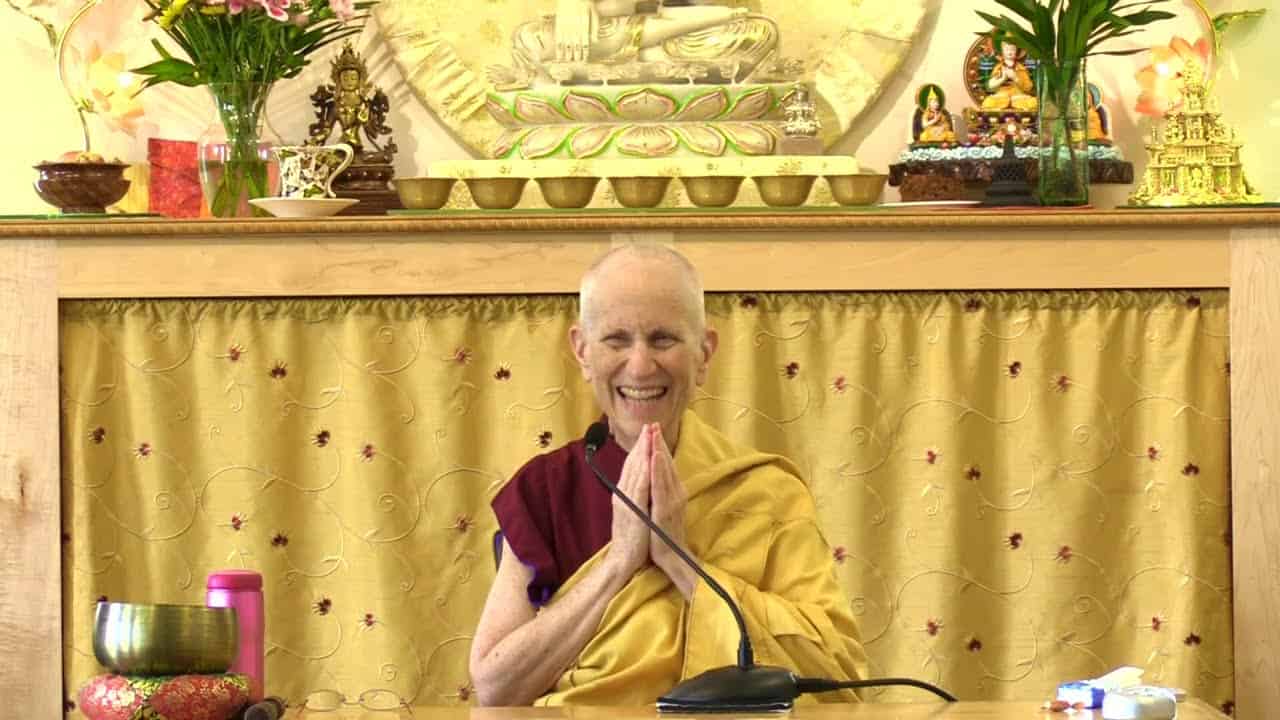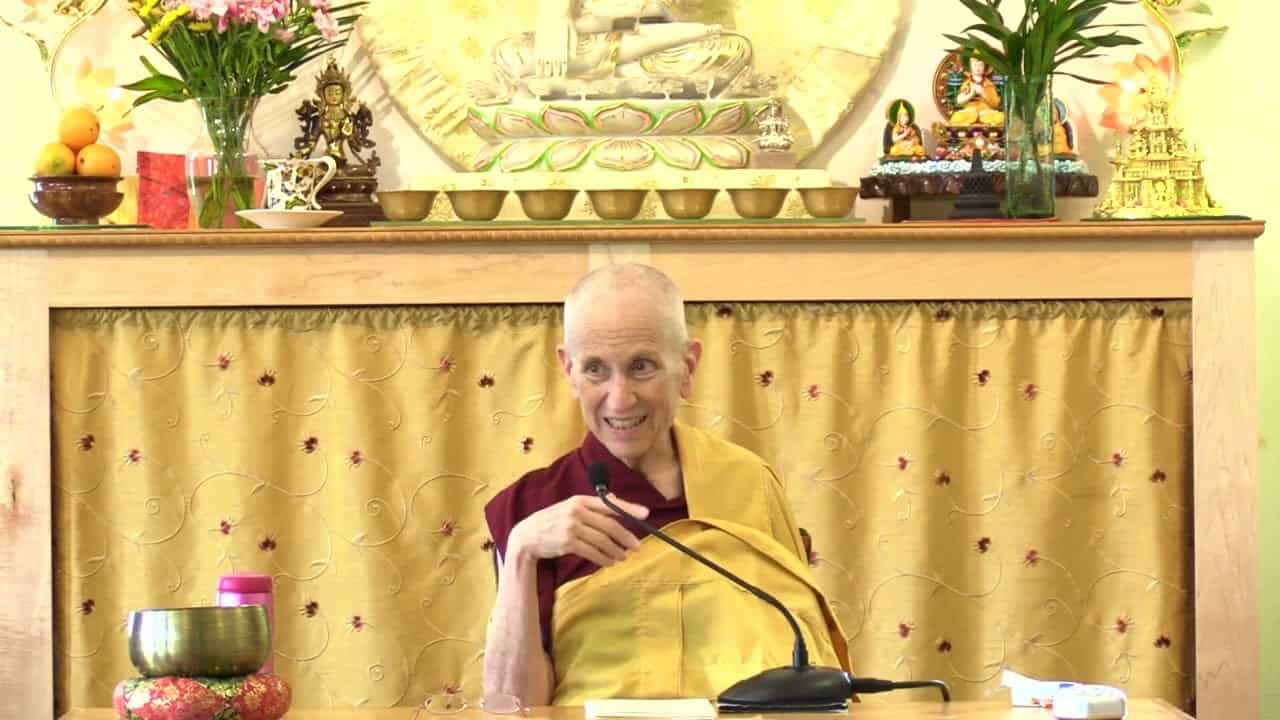Sakyadhita: Daughters of the Buddha

Venerable Jampa reports from the 18th Sakyadhita International Conference in Seoul, South Korea, which she attended at the request of Venerable Thubten Chodron.
Some months ago, Venerable Chodron asked me if I would join Venerable Samten to hold a workshop at the 18th Sakyadhita International Conference in Seoul, South Korea. Of course I could not say no. This was an amazing opportunity to share my experiences training at Sravasti Abbey for about 11 years and to connect with so many amazing women and men, supporting each other in our endeavor to empower women worldwide. Venerable Chodron also told me it’s a helpful conference if one is interested in forming a community. And indeed it was!
This paper is a short summary of some of the lectures, discussions, and cultural activities that were held at Sakyadhita 2023. I will include my personal experience as well as information from conference meetings. On the fourth day, Venerable Samten and I had the opportunity to present a workshop entitled “Monastic Training for Buddhist Nuns” as an essential part of empowering nuns.
Friday–Saturday, June 23–24
This was the first in-person Sakyadhita conference since 2019, due to Covid. Therefore, many participants looked forward to this 2023 conference in Seoul. The event was held at the Coex Convention & Exhibition Center, Seoul’s largest event center in the Gangnam District. There were around 3,000 attendees from Friday till Tuesday and on Sunday that number grew to around 5,000 participants who found their seats to attend the many paper presentations, cultural performances, meditations, tea ceremonies, and an evening lecture on the topic, “Living in a Precarious World: Impermanence, Resilience, Awakening.” The nearby Korean temple Bongeunsa, of the Jogye Order, co-sponsored the event along with several governmental departments, including the Ministry of Culture, Sports, and Tourism, and the Seoul Metropolitan Government. They took on the huge task of feeding up to 3,000 people and, on Sunday, 5,000 people three times a day! Venerable Samten and I were amazed by this endeavor.
For me, it was surprising that at the opening ceremony, the Mayor of Seoul, Oh Se-hoon, and even the President of Korea, Yoon Suk-yeol, sent their representatives to give messages to all the Sakyadhita participants. It was just amazing to hear how supportive the government is to host Sakyadhita in Seoul. They spoke with great admiration about the bhiksuni sangha and the Buddha’s teachings. I was in awe, thinking how wonderful it would be if our leaders in Europe or the US would speak with such respect about monastics, about Buddha and his teachings—if they would support Buddhist events like this in our cities. Unimaginable at this point. But “I have a dream” that at some point, politicians will see the truth in Buddha’s teachings and will come to respect it.
Korea has a long history of Buddhism, dating back to the fourth century. Today though, only about 15.5% of the Korean people are Buddhist. More of these historical facts were presented on the second day, with a keynote speaker from Korea, Eun-su Cho. Her talk was titled, “What does Modernity Mean for 19th-Century Buddhist Women in Korea?” Women worked especially hard to create better conditions for their practice and to create a more meaningful life in the Dharma.
Another presentation was about the initiation of a Korean bhiksuni database that contains the stories of hundreds of bhiksunis, their biographies, their workings, their writings, and so on. Those who manage the project hope the databank will be enriched with monastics and laywomen from all over the world.
Sunday–Tuesday, June 25–27
On Sunday, the paper sessions in the morning were all about the topic of “Women’s Ordination, Past and Present.” Gelongmas Pema Dekyi and Namgyel Lhamo are two bhiksunis who spoke about the bhiksuni ordination in the Mūlasarvāstivāda in Bhutan that happened in June 2022. Together with Dr. Tashi Zangmo (Bhutan Nuns Foundation), they shared how everything evolved—the joys and challenges of preparing the bhiksuni ordination of 144 nuns from seven different monasteries in Bhutan and a small number of nuns from other countries.
In 2021, His Majesty the King of Bhutan, Jiggle Khesar Namgyel Wangchuck, made a royal supplication, asking His Holiness the Je Khenpo, who is the head of the Drug Kagyu lineage in Bhutan, to grant full bhiksuni ordination. This is also supported by the Queen, Her Majesty Jetsun Pema Wangchuk. They conducted the ordination and training of these nuns. This ordination event was historic and is planned to continue every two years. This will bring huge changes to the nuns in their ability to lead their own communities and uphold the teachings and the Vinaya.
A scholar from the Cambodian Buddhist community, Marla Ouch, presented the situation in Cambodia, where bhiksunis are still not accepted. She founded the Cambodian Sangha Initiative, supporting (so far) a small number of nuns who wish to receive training as sramaneris and eventually become ordained as bhiksunis. Unfortunately, monks in Cambodia hold the belief that the bhiksuni lineage has been broken and therefore, women can no longer be ordained as bhiksunis.
Vanessa R. Sasson presented her new book, The Gathering: A Story of the First Buddhist Women. With great passion for the nuns and their history, she shared how she came to write this book, the challenges and joys she encountered along the way, and what she hopes readers will get out of the book. It took her many years of research and personal development to be able to write this story about the first Buddhist women and their first steps to request ordination from the Buddha. They showed great perseverance in their quest for ordination that, even today, inspires so many women who are following in their footsteps.
On the morning of the next day, all the presentations were about the topic pilgrimage, precarity, and practice. Many papers where presented, including a paper from a female Buddhist traveler in Bodhgaya about how this holy place is still a place where women are very underrepresented. Another presentation dealt with the situation of the Sri Lankan bhiksunis during Covid and how they continued their monastic life during this precarious time.
In the afternoon, Venerable Samten and I gave a 1.5-hour workshop. We gave a brief presentation on the history and founding of Sravasti Abbey and developing a monastic community. We shared at length how we learned the monastic rituals and the procedures for training as a monastic at Sravasti Abbey. We also facilitated a discussion group, as this is an essential part of learning to integrate the Buddhist teachings into our lives.
On the last day, all presentations dealt with the topic of manifesting the Buddhadharma—how Buddhist practitioners apply the Dharma within their communities as chaplains, and in prevention work ending violence against women and in families. A young teacher shared about engaged youths learning from Buddhist temples in Massachusetts. There was also one young bhiksuni from the Vietnamese tradition who presented practices of compassion to counteract a widespread phenomena of loneliness, which I hope enriched people greatly.
In the break time and evenings, a huge cultural program was offered: galleries with Buddhist images, photo exhibits, tea ceremonies, traditional handcrafts such as making paper lanterns, dance and music, and more. At the beginning, middle, and end of the conference, we saw many performances of great musicians, traditional drum performances, chanting, and such.
The grand finale
On the last day, Sakyadhita ended the conference with a closing session and a tour of Jingwansa Temple. It was another day of amazing presentations, dedications, musical performances, group discussion, and more. This was also a day where the different national branches of Sakyadhita came together to meet each other and give their pledges.
I had the opportunity to meet the co-founders of Sakyadhita Germany and France, Dr. Thea Mohr and Gabriela Frey. And while joining a short group discussion on the “Future of Buddhist Monasticism” with Korean nuns and laypeople, it turned out that they really encouraged me to meet the president, Venerable Bon Gak, of the Korean Bhiksuni Association of the Jogye Order, who was also the president of this Sakyadhita Seoul Conference. An English-speaking nun introduced me to Venerable Bon Gak, sharing my aspiration to support a nuns community in Germany or Europe. Venerable Bon Gak expressed her support and encouraged me, along with other Korean nuns, to do this important task.
This experience was surely due to the wise and compassionate means of my teacher Venerable Chodron. She could foresee that being at the Sakyadhita Conference would be of benefit, as it helps to make meaningful connections that will be inspiring and supportive while proceeding on the path.
The conference was, for me, one of the most memorable events I have experienced. I enjoyed spending time with Venerable Samten and so many other nuns and practitioners in Seoul, exchanging our thoughts, our struggles, our hopes, our knowledge, and encouraging each other along the path.
A letter from a participant
After the conference, I received the following letter from an attendee that brought into focus the importance of organizations such as Sakyadhita:
Attending the conference caused me to be more aware of gender issues. I forgot that I was trained that men are the important figures in the Dharma. When I first met a woman teacher I was very surprised seeing a woman teacher being respected as a good teacher and a strong leader. Initially I had problems accepting this myself as it was so unfamiliar. But over time, I understood that respect does not depend on someone’s gender but on their internal qualities and behavior.
Now being back at the Dharma center I attend, I’m sad seeing the dominance of men here. But I cannot force change so I try not focus on it. However, I am sad to see that 90 % of the teachers and the leadership are male. Even the magazine the center publishes has few articles by women or interviews of female practitioners. I’m seeing too that sometimes women support the men being prominent.
But I can’t blame my own lack of self-confidence on men or anyone else. I must understand my own potential and support other women to understand theirs. I’m grateful to the women Dharma teachers and other women I met at Sakyadhita for being such good role models, teaching us to take our place and to be leaders according to our capacities.
Read more: “Daughters of the Buddha: 18th Sakyadhita Conference in Seoul Celebrates the Sacred Feminine” July 11, 2023, Buddhistdoor Global
Bhikshuni Thubten Jampa
Bhikshuni Thubten Jampa is from Hamburg, Germany. She took refuge in 2001. Bhikshuni Jampa studied politics and sociology for 5 years at the Humboldt-University in Berlin and received her master in Social Science in 2004. Afterwards she worked for the International Campaign for Tibet (ICT) in Berlin till 2007 and for the Tibetan Center Hamburg from 2007-2011. She completed monastic training at Sravasti Abbey, USA from 2011-2022. Today she lives in Hamburg again as a fully ordained nun (Bhikshuni) and studies full-time at the Dharma College at the Tibetan Centre. She occasionally offers lectures, retreats, regular meditations and a study group at the Buddhist Society Hamburg and if requested at the Tibetan Centre, among other places. Bhikshuni Thubten Jampa is also involved in the Hamburg Buddhist Society (BGH).


